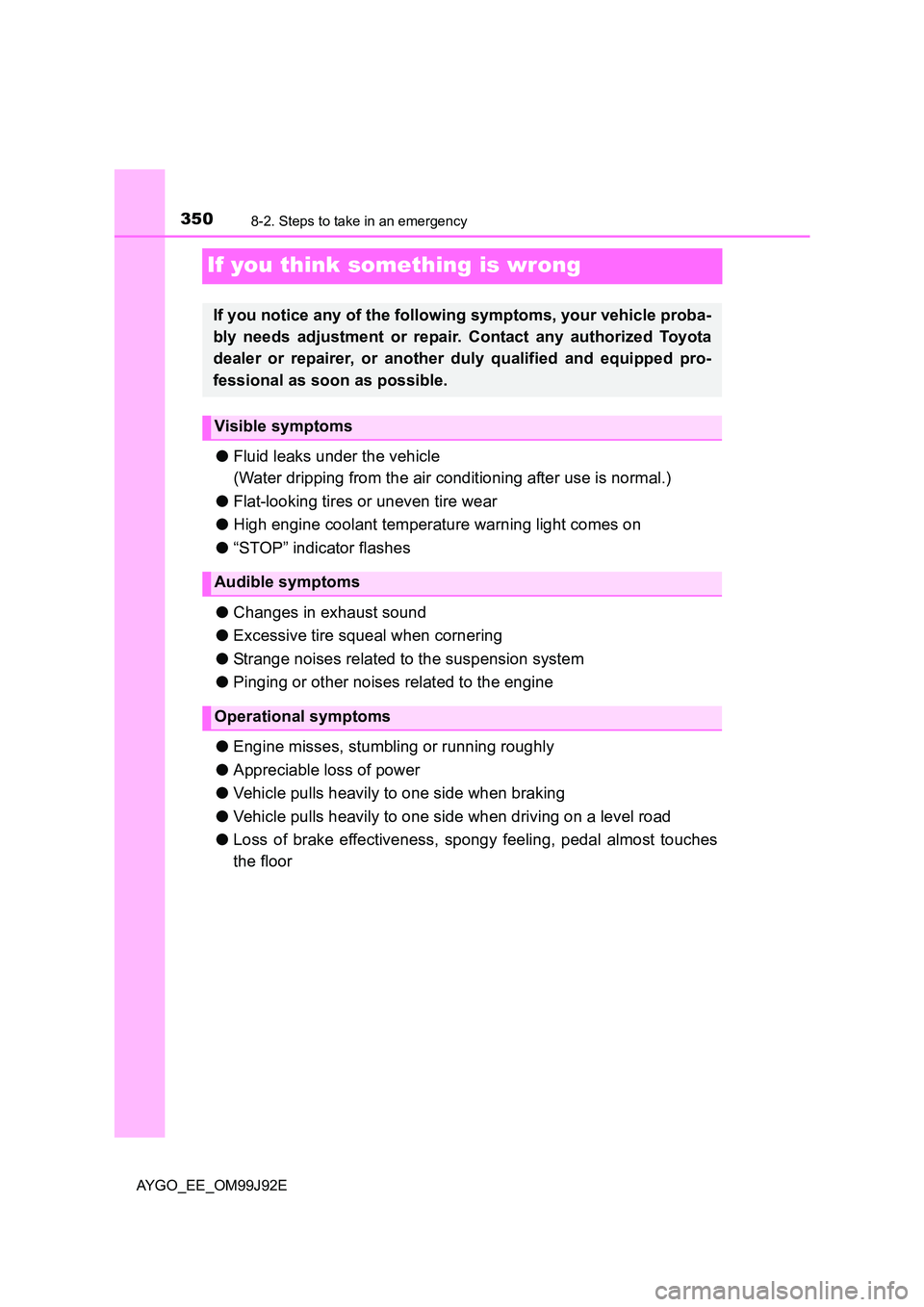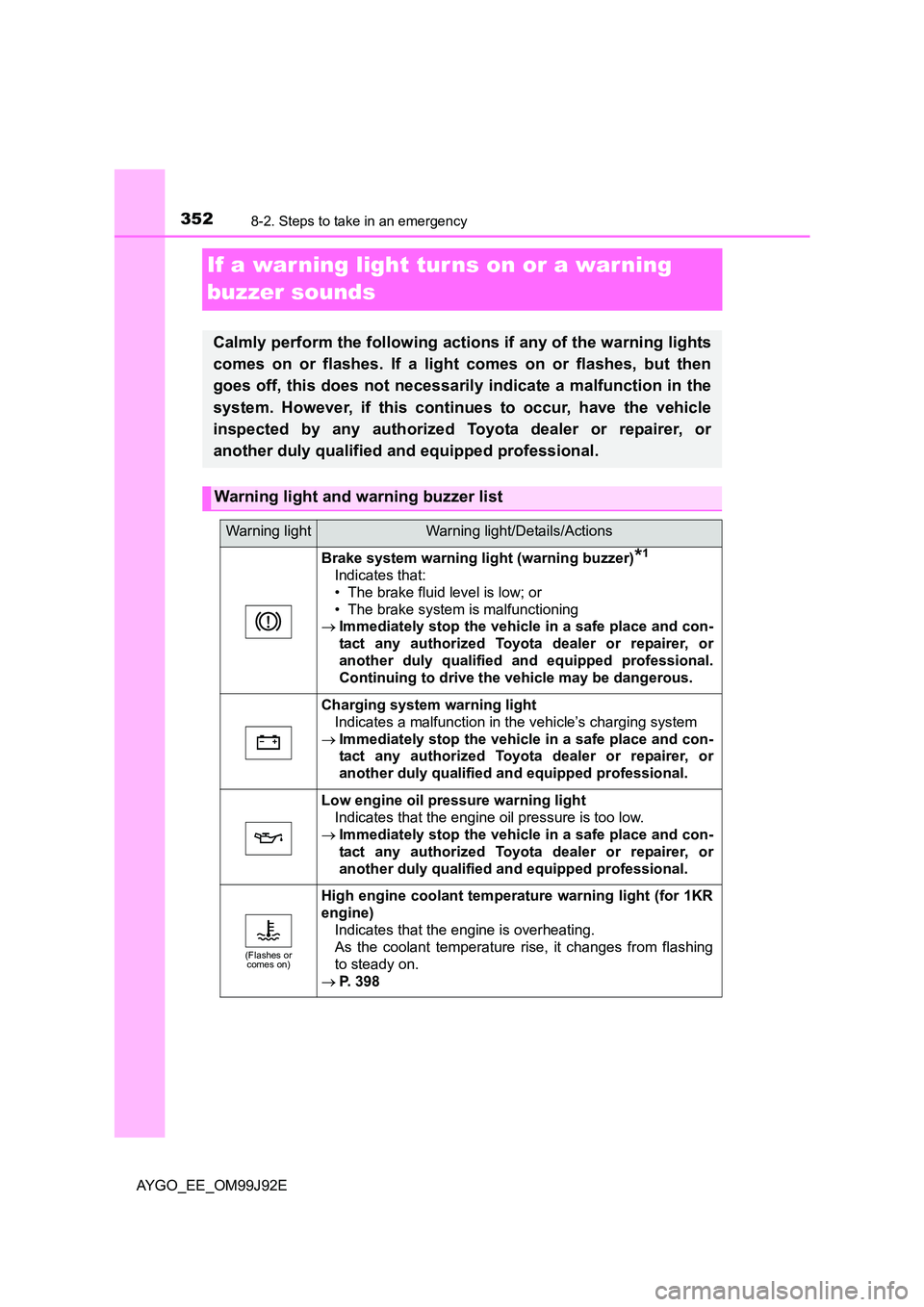2015 TOYOTA AYGO coolant temperature
[x] Cancel search: coolant temperaturePage 79 of 440

792. Instrument cluster
2
Instrument cluster
AYGO_EE_OM99J92E
Warning lights inform the driver of malfunctions in the indicated vehi-
cle’s systems.
Warning lights
*1
Brake system warning
light ( →P. 352)
*2, 3, 4
(Yellow)
Speed limiter indicator
( →P. 354)
*1
Charging system
warning light ( →P. 352)
*2, 5
Speed limiter indicator
( →P. 354)
*1
Low engine oil pressure
warning light ( →P. 352)
*1, 2, 6
Stop & Start cancel
indicator ( →P. 354)
*1High engine coolant
temperature warning
light ( →P. 352, 353)
*1, 2
Slip indicator (→P. 355)
*1
“STOP” warning light
( →P. 353)
*2, 7
(Yellow)
Smart entry & start
system indicator light
( →P. 355, 359)
*1, 2Multi-mode manual
transmission
warning light ( →P. 353)
Open door warning light
( →P. 355)
*1
Malfunction indicator
lamp ( →P. 354)
*8Driver’s and front pas-
senger’s seat belt
reminder light ( →P. 355)
*1
SRS warning light
( →P. 354)
*2, 9
Rear passengers’ seat
belt reminder lights
( →P. 355)
*1
ABS warning light
( →P. 354)
Low fuel level warning
light ( →P. 355)
*1Electric power steering
system warning light
( →P. 354)
*1, 2
Tire pressure warning
light ( →P. 356)
Page 82 of 440

822. Instrument cluster
AYGO_EE_OM99J92E
WARNING
■ If a safety system warning light does not come on
Should a safety system light such as the ABS and SRS warning light not
come on when you start the engine, this could mean that these systems are
not available to help protect you in an accident, which could result in death
or serious injury. Have the vehicle inspected by any authorized Toyota
dealer or repairer, or another duly qualified and equipped professional
immediately if this occurs.
NOTICE
■ To prevent damage to the engine and its components
The engine may be overheating if the high engine coolant temperature
warning light flashes or turns on. In this case, immediately stop the vehicle
in a safe place, and check the engine after it has cooled completely.
( →P. 398)
Page 187 of 440

1874-5. Using the driving support systems
4
Driving
AYGO_EE_OM99J92E
● In the following circumstances the engine may not be stopped by the Stop &
Start system. This is not a malfunction of the Stop & Start system.
• The engine coolant temperature is extremely high or low.
• The outside temperature is extremely low.
• The air conditioning system is being used when the vehicle interior tem-
perature is extremely high such as after the vehicle was parked under the
hot sun.
• The air conditioning system is being used when the outside temperature
is high or low.
• Vehicles with an automatic air condi tioning system only: The windshield
defogger is being used.
• The battery is not sufficiently charged, or is undergoing a periodic
recharge.
• Due to traffic or other circumstances the vehicle is stopped repeatedly,
resulting in the amount of time the engine is stopped by the Stop & Start
system to become excessively high.
• The brake booster vacuum is low.
• A large amount of electricity is being used.
• At high altitude.
When the above conditions improve, the Stop & Start system will stop and
restart the engine from the next time the vehicle is stopped.
● In the following situations, the engine may start even without the clutch
pedal being depressed.
• The brake pedal is pumped or strongly depressed.
• The air conditioning system is being used or turned on.
• Vehicles with an automatic air condi tioning system only: The windshield
defogger is turned on.
• The battery is not sufficiently charged.
• The vehicle starts to roll on an incline.
• A large amount of electricity is being used.
• The driver’s door is opened.
• The driver’s seat belt is unfastened.
● In the following situations, it may take longer than normal for the Stop & Start
system to activate.
• The battery is discharged.
• After the battery terminals have been disconnected and reconnected
after a battery replacement, etc.
• The engine coolant temperature is low.
Page 289 of 440

2897-2. Maintenance
7
Maintenance and care
AYGO_EE_OM99J92E
■ Does your vehicle need repairs?
Be on the alert for changes in performance and sounds, and visual tip-offs
that indicate service is needed. Some important clues are:
● Engine misses, stumbling or pinging
● Appreciable loss of power
● Strange engine noises
● A fluid leak under the vehicle (However, water dripping from the air condi-
tioning system after use is normal.)
● Change in exhaust sound (This may indicate a dangerous carbon monoxide
leak. Drive with the windows open and have the exhaust system checked
immediately.)
● Flat-looking tires, excessive tire squeal when cornering, uneven tire wear
● Vehicle pulls to one side when driven straight on a level road
● Strange noises related to suspension movement
● Loss of brake effectiveness, spongy feeling brake pedal or clutch pedal,
pedal almost touches the floor, vehicle pulls to one side when braking
● Engine coolant temperature continually higher than normal
If you notice any of these clues, take your vehicle to any authorized Toyota
dealer or repairer, or another duly qualified and equipped professional as
soon as possible. Your vehicle may need adjustment or repair.
WARNING
■ If your vehicle is not properly maintained
Improper maintenance could result in serious damage to the vehicle and
possible death or serious injury.
■ Handling of the battery
Battery posts, terminals and related accessories contain lead and lead com-
pounds which are known to cause brain damage. Wash your hands after
handling. ( →P. 303)
Page 292 of 440

2927-3. Do-it-yourself maintenance
AYGO_EE_OM99J92E
WARNING
■ When working near the electric cooling fans or radiator grille
�XVehicles without a smart entry & start system
Be sure the engine switch is off. With the engine switch in the “ON” position,
the electric cooling fans may automatical ly start to run if the air conditioning
is on and/or the coolant temperature is high. ( →P. 303)
�XVehicles with a smart entry & start system
Be sure the engine switch is off. With the engine switch in IGNITION ON
mode, the electric cooling fans may automatically start to run if the air condi-
tioning is on and/or the coolant temperature is high. ( →P. 303)
■ Safety glasses
Wear safety glasses to prevent flying or falling material, fluid spray, etc.,
from getting in your eyes.
NOTICE
■ If you remove the air cleaner filter
Driving with the air cleaner filter removed may cause excessive engine wear
due to dirt in the air.
■ If the fluid level is low or high
It is normal for the brake fluid level to go down slightly as the brake pads
wear or when the fluid level in the accumulator is high.
If the reservoir needs frequent refilling, it may indicate a serious problem.
Page 302 of 440

3027-3. Do-it-yourself maintenance
AYGO_EE_OM99J92E
�XHM01 engine
Reservoir cap
“MAX” line
“MIN” line
If the level is on or below the “MIN”
line, add coolant up to the “MAX”
line.
■ Coolant selection
�X1KR engine
Only use “Toyota Super Long Life Coolant” or a similar high quality ethylene
glycol based non-silicate, non-amine, non- nitrite, and non-borate coolant with
long-life hybrid organic acid technology.
“Toyota Super Long Life Coolant” is a mixture of 50% coolant and 50%
deionized water. (Minimum temperature: -35 °C [-31°F])
�XHM01 engine
Only use “Toyota Genuine Premium Long Life Coolant 2WZ-TV” or a similar
high quality ethylene glycol based non-s ilicate, non-amine, non-nitrite, and
non-borate coolant with long-life hybrid organic acid technology.
“Toyota Genuine Premium Long Life Coolant 2WZ-TV” is a mixture of 50%
coolant and 50% deionized water. (Minimum temperature: -38 °C [-36°F])
For more details about coolant, contact any authorized Toyota dealer or
repairer, or another duly qualified and equipped professional.
■ If the coolant level drops within a short time of replenishing
Visually check the radiator, hoses, engine coolant reservoir cap, drain cock
and water pump.
If you cannot find a leak, have any authorized Toyota dealer or repairer, or
another duly qualified and equipped professional, test the cap and check for
leaks in the cooling system.
1
2
3
WARNING
■ When the engine is hot
Do not remove the radiator cap (1KR engine) and the engine coolant reser-
voir cap (HM01 engine).
The cooling system may be under pressure and may spray hot coolant if the
cap is removed, causing serious injuries, such as burns.
Page 350 of 440

3508-2. Steps to take in an emergency
AYGO_EE_OM99J92E
If you think something is wrong
●Fluid leaks under the vehicle
(Water dripping from the air conditioning after use is normal.)
● Flat-looking tires or uneven tire wear
● High engine coolant temperature warning light comes on
● “STOP” indicator flashes
● Changes in exhaust sound
● Excessive tire squeal when cornering
● Strange noises related to the suspension system
● Pinging or other noises related to the engine
● Engine misses, stumbling or running roughly
● Appreciable loss of power
● Vehicle pulls heavily to one side when braking
● Vehicle pulls heavily to one side when driving on a level road
● Loss of brake effectiveness, spongy feeling, pedal almost touches
the floor
If you notice any of the following symptoms, your vehicle proba-
bly needs adjustment or repair. Contact any authorized Toyota
dealer or repairer, or another duly qualified and equipped pro-
fessional as soon as possible.
Visible symptoms
Audible symptoms
Operational symptoms
Page 352 of 440

3528-2. Steps to take in an emergency
AYGO_EE_OM99J92E
If a war ning light tur ns on or a warning
buzzer sounds
Calmly perform the following actions if any of the warning lights
comes on or flashes. If a light comes on or flashes, but then
goes off, this does not necessarily indicate a malfunction in the
system. However, if this continues to occur, have the vehicle
inspected by any authorized Toyota dealer or repairer, or
another duly qualified and equipped professional.
Warning light and warning buzzer list
Warning lightWarning light/Details/Actions
Brake system warning light (warning buzzer)*1
Indicates that:
• The brake fluid level is low; or
• The brake system is malfunctioning
→ Immediately stop the vehicle in a safe place and con-
tact any authorized Toyota dealer or repairer, or
another duly qualified and equipped professional.
Continuing to drive the vehicle may be dangerous.
Charging system warning light
Indicates a malfunction in the vehicle’s charging system
→ Immediately stop the vehicle in a safe place and con-
tact any authorized Toyota dealer or repairer, or
another duly qualified and equipped professional.
Low engine oil pressure warning light
Indicates that the engine oil pressure is too low.
→ Immediately stop the vehicle in a safe place and con-
tact any authorized Toyota dealer or repairer, or
another duly qualified and equipped professional.
(Flashes or comes on)
High engine coolant temperature warning light (for 1KR
engine)
Indicates that the engine is overheating.
As the coolant temperature rise, it changes from flashing
to steady on.
→ P. 398